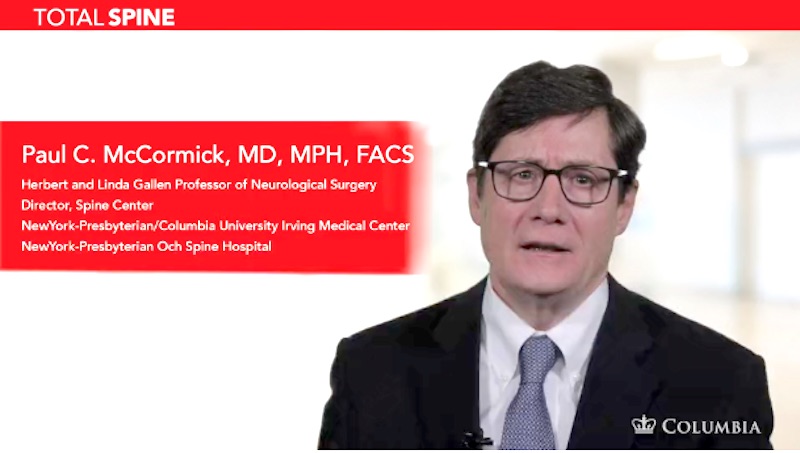No one who meets Candace Moose would think to call her fragile. “I’m really not,” she says. Despite having had a heart transplant in 2001, she leads an active life and loves to cook for her family and her community. But the heart transplant does make her more medically complicated than the average patient, and that’s why she came to Columbia University Medical Center/NewYork-Presbyterian Hospital for her complex spine surgery. “When you’re considered ‘medically fragile,’ you go to one of the top places in the country,” she says.
Candace’s spine problems began decades ago. When she was 19, her life was moving along at a good clip: She was ready to pursue her nursing degree at Cornell, and she had met her husband-to-be. So when a specialist diagnosed her with scoliosis and recommended that she undergo surgery—then spend a year recovering in a body cast—she emphatically declined. She says now, “I didn’t have time!”
In the decades that followed, Candace had occasional episodes of back pain, “when one or another disc would go out.” But by then, involved in her nursing career and raising her children, she handled each episode and moved on. By the time she was 50, she’d had a heart transplant. Images that had been taken in preparation for that, she says, showed most of the discs in her spine had herniated. Still she didn’t consider spinal surgery.
Then a couple of years ago, Candace’s back got a lot worse. Her lower back hurt constantly, and she started having trouble standing. “I love to cook, and I kept picking shorter and shorter recipes because my leg would go numb if I stood for any length of time.” Because of her nursing background, she suspected this was due to a condition called spinal stenosis, a narrowing of the spinal canal that pinches nerves.
The new pain and occasional numbness were starting to change Candace’s active, heart-healthy lifestyle. She found she was arranging her days to involve less and less standing and walking. Then, while she was grocery shopping one day, both of her legs went numb. “I’m standing there with a cart full of groceries, and I can’t feel my legs,” she says. “I thought to myself, ‘If I don’t do something about this, I’m going to be in big trouble.’ ”
It was a Columbia team that performed Candace’s heart transplant, so she was familiar with Columbia’s superb standard of care. She made an appointment with the director of Columbia Neurosurgery’s spine program, The Spine Hospital at the Neurological Institute of New York, Dr. Paul McCormick. Dr. McCormick is a world-class spine surgeon and a stenosis specialist, but as Candace found out, that’s not all he is. “Picking a neurosurgeon, I wasn’t necessarily looking for personality, you know?” she says with a smile. “I just wanted him to be good, and I was thinking, This guy is the head of the Spine Hospital at Columbia; this guy is good. Well, it turns out he’s a really nice guy, too—just a really nice guy.”
At their meeting, Candace says, “He was very serious, all business, and he answered all my questions thoroughly.” Dr. McCormick told Candace he could help her with the stenosis. But because she also had scoliosis and degeneration in the rest of her spine, he thought they should consult with fellow Spine Hospital neurosurgeon Dr. Peter Angevine, a renowned expert in spinal deformity. Correcting the structure of her spine might be necessary in order to relieve pain and stabilize her spine over the longer term.
“All of a sudden that became, to me, a much bigger operation,” says Candace. Dr. McCormick and Dr. Angevine proposed to decompress her spinal column (free up enough room for her spinal cord and nerves), re-align her spine in a more stable arrangement and then use a bone graft and metal hardware to fix her spine in the new alignment.
After meeting with the surgeons, Candace found that she trusted their individual expertise and their joint collaboration. The only remaining question for Candace and her surgeons was whether she would be cleared by her heart team for such a complex operation.
After a careful review, Candace’s team of heart doctors gave their clearance, and the spine surgery was scheduled. During the eight-hour procedure, each surgeon performed the aspect of the surgery in which he is the expert: Dr. McCormick decompressed the spinal canal’s stenosis, and Dr. Angevine realigned the spine from its scoliosis. “The surgery went beautifully,” says Candace.
Jane Kostadinov, the nurse practitioner at The Spine Hospital at the Neurological Institute of New York, was invaluable throughout Candace’s recovery at home. “She was on call for every question I had: What should I do about these side effects? May I shower yet? When does the bandage come off? She was a welcome, sage and very professional voice that led me through everything in the recovery period. She was just wonderful.”
Candace stuck closely to the doctors’ orders during recovery. “They said to walk, so my husband and I took the walker out and walked every single day, 1.6 miles, in the park next door. When I could, I went from the walker to walking sticks. And then I deep-sixed the walking sticks when I felt like I could go by myself.”
Now, a year after surgery, Candace has no pain.
“I’m free to do anything I want,” she says. “I’m very active in my church, and I cook for people in crisis or who just need a helping hand.” She also cooks with her grandchildren, ages 13 and 8. “They have their favorite recipes. Whenever the family visits I like to have something cooking in the oven.”
Back on her feet, Candace is putting big smiles on lots of faces—and good food in lots of bellies.
Learn more about Dr. Paul McCormick at his bio page here.



